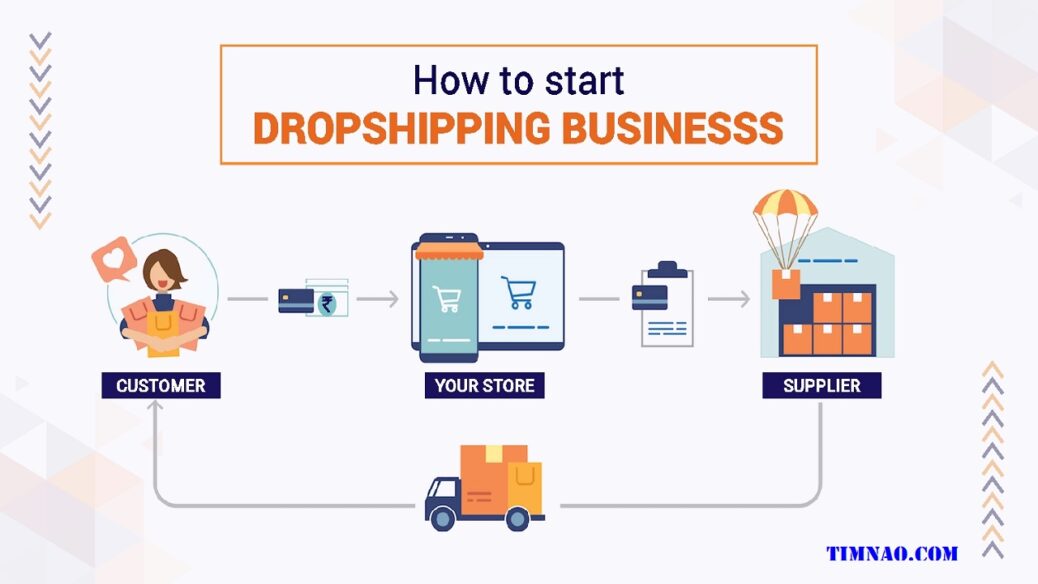🚀 What is Dropshipping?
Dropshipping is a business model that allows you to sell products online without holding inventory. You act as the middleman between the customer and supplier — when someone buys from your store, the supplier ships the product directly to the customer.
Unlike traditional retail or eCommerce, you don’t buy products upfront or manage logistics. This model is popular for entrepreneurs who want to start an online business with low investment and minimal risk.
🔍 How Dropshipping Works (Simplified)
At its core, a dropshipping business is an e-commerce model where you, the retailer, don’t keep the products you sell in stock. Instead, when you sell a product, you purchase the item from a third party – usually a wholesaler or manufacturer – who then ships the product directly to the customer.
Here’s how a typical dropshipping process looks like:
- You create an online store and list products from a supplier.
- A customer places an order on your site.
- You forward the order to the supplier and pay the wholesale price.
- The supplier ships the product directly to your customer.
- You keep the profit (retail price – wholesale cost).
📦 Example:
- Retail Price: $50
- Supplier Price: $30
- Your Profit: $20 (before ads and fees)
Essentially, you act as the storefront and marketer – the middleman connecting the customer to the product – while the supplier handles all the inventory management and logistics.
Understanding Your Role in the Dropshipping Supply Chain
While suppliers handle the physical product journey, your role as the dropshipper is critical. You are the bridge between the supplier and the customer, and your responsibilities include:
- Product Curation & Supplier Vetting: Choosing the right products and finding reliable suppliers is paramount. Your product choices define your brand, and supplier reliability impacts customer satisfaction. Research trends, vet supplier reviews and shipping times, and ideally, test products yourself.
- Marketing & Sales: This is arguably your most important job. You need to drive traffic to your store and convert visitors into customers. This involves creating a strong brand image and utilizing marketing strategies like social media ads, SEO, and email marketing.
- Order Processing & Customer Service: You ensure orders are correctly forwarded to the supplier and manage all customer communication. Handling inquiries, resolving issues (like shipping delays or returns) promptly and professionally is crucial for building trust and loyalty. You are the face of the business to the customer.
Building strong relationships with reliable suppliers through clear communication is key to smooth operations.
💡 Dropshipping vs Drop Servicing
People often confuse these two — so let’s clear it up.
| Feature | Dropshipping | Drop Servicing |
|---|---|---|
| Product Type | Physical products | Digital services |
| Delivery Time | Dependent on supplier shipping | Instant or custom (e.g., graphic design, SEO) |
| Inventory Needed | No | No |
| Supplier Role | Fulfills product | Completes service |
| Customer Relationship | Product-focused | Service experience-focused |
| Risk | Product quality/shipping issues | Service quality inconsistency |
👉 In short:
- Dropshipping = selling physical products.
- Drop servicing = reselling digital services.
🌟 Why Dropshipping is Still a Good Idea in 2025
Despite the challenges and increased competition, dropshipping still works — when done right. Here’s why it’s still a viable business:
✅ Low Startup Cost
You can start with as little as $100–$300, especially using platforms like Shopify, WooCommerce, or even TikTok Shops.
✅ Scalable
Once you find a winning product and marketing strategy, you can scale up quickly using ads or influencers.
✅ No Inventory Hassles
Focus on marketing, branding, and customer support — let the supplier handle product fulfillment.
✅ Location Independent
You can run your business from anywhere in the world with Wi-Fi and a laptop.
🚫 Why Most Dropshipping Businesses Fail
Let’s get real. Up to 90% of dropshipping stores fail within the first few months. Why? Let’s break down the reasons:
1. No Product Research
They sell what they like, not what customers want.
➡️ Use tools like Sell The Trend, AliShark, or Amazon Movers & Shakers to find trending products.
2. Poor Branding
Generic store name, stock photos, and zero trust-building = no sales.
3. Long Shipping Times
Most beginners rely on AliExpress with 3-4 week delivery. Customers today expect fast delivery — or they go to Amazon.
4. Low-Quality Suppliers
Unreliable suppliers can destroy your reputation.
✅ Use vetted platforms like CJ Dropshipping, Zendrop, or Spocket.
5. No Customer Support
No one responds to questions, issues, or refunds. That kills repeat business and gets you banned on payment gateways.
6. Over-Reliance on Facebook Ads
Paid traffic is expensive. Without proper targeting and testing, you’ll burn your budget quickly.
💡 Combine organic content (TikTok, Pinterest, SEO) with ads.
7. No Differentiation
If your store looks and feels like thousands of others, why should someone buy from you?
🛠️ How to Start a Profitable Dropshipping Business in 2025 (Step-by-Step)
✅ Step 1: Choose a Niche
Pick a niche that balances passion + demand + profit. Examples:
- Pet Accessories
- Home Fitness
- Car Gadgets
- Eco-friendly Products
Choosing the right niche – a specific segment of the market you target – is arguably the most critical step. Don’t just chase trends or pick something random. A good niche balances demand with manageable competition.
How to Identify Profitable Niches:
- Follow Your Passion (Strategically): Starting with interests makes the journey enjoyable, but validate it with market demand. Use your knowledge to connect with the audience.
- Solve Problems or Serve Hobbies: Products that solve a specific pain point or cater to passionate hobbyists often sell well. Think about communities with dedicated followings.
- Market Research is Non-Negotiable:
- Google Trends: Analyze search interest over time for product ideas. Identify upward trends.
- Keyword Research Tools (e.g., Ahrefs, SEMrush): Gauge search volume and competition for product keywords. Look for “long-tail” keywords (more specific phrases) indicating buyer intent.
- Competitor Analysis: See what existing stores in potential niches are doing. Identify gaps, weaknesses (poor service, slow shipping), or underserved segments you can target.
- Social Media & Forums: Monitor platforms like Reddit, Facebook Groups, Pinterest Trends, and TikTok to see what people are talking about and buying.
- E-commerce Marketplaces (Amazon, Etsy): Browse best-seller lists and customer reviews for ideas and pain points. Tools like Jungle Scout can provide sales estimates.
- Profitability Check: Ensure potential products have healthy margins. Aim for products priced high enough (e.g., $20-$50+) to cover supplier costs, marketing, fees, and still yield profit. Factor in potential shipping costs.
- Avoid Oversaturation (or Find an Angle): Highly competitive niches require significant differentiation. If entering a crowded space, find a unique angle, target a sub-niche, or offer superior branding/service.
✅ Step 2: Find Winning Products
Use platforms like:
- Dropship.io
- TikTok Trends
- AliExpress “Orders” filter
- Shopify App “DSers”
Look for:
- High margins
- Unique appeal
- Solves a problem
✅ Step 3: Set Up Your Store
Choose a platform:
- Shopify (Beginner-friendly)
- WooCommerce (More flexible)
- BigCommerce / Squarespace
Install essential apps:
- Product import tool (DSers, CJ)
- Email marketing (Klaviyo)
- Reviews (Loox or Judge.me)
- Upsell app
✅ Step 4: Find a Reliable Supplier
- Test order products
- Communicate regularly
- Use agents for better pricing & faster delivery
Your suppliers are the backbone of your dropshipping business. Their reliability directly impacts your brand reputation.
Platforms & Vetting:
- Supplier Marketplaces:
- AliExpress: Massive selection, widely used, but requires careful vetting due to varying supplier quality.
- SaleHoo: Directory of pre-vetted suppliers, often with higher quality but requires a membership fee.
- Spocket: Focuses on US/EU suppliers for faster shipping, integrates with platforms like Shopify.
- CJ Dropshipping: Offers product sourcing, warehousing, and faster shipping options than AliExpress.
- Others: Doba, Worldwide Brands, Modalyst, etc.
- How to Vet Suppliers:
- Check Reviews & Ratings: Look for consistent positive feedback on product quality, communication, and shipping.
- Order Samples: Always order product samples yourself to assess quality, packaging, and actual shipping times before listing them. This is non-negotiable.
- Communicate: Reach out with questions. Gauge their responsiveness (aim for <48hr replies), professionalism, and transparency about policies.
- Assess Shipping Policies: Understand their processing times, shipping methods, costs, and average delivery times to different regions. Look for suppliers offering reliable tracking.
- Verify Business Legitimacy: Check if they have official licenses or certifications if relevant to the product type.
- Building Relationships: Treat suppliers as partners. Communicate clearly and respectfully, pay promptly, provide constructive feedback, and explore long-term collaborations as you grow. Having backup suppliers is also wise.
✅ Step 5: Build a Brand
- Use a unique logo & theme
- Write original product descriptions
- Add trust badges, FAQs, and real testimonials
This is your digital storefront. It needs to be professional, user-friendly, and optimized for conversions.
- Choose a Platform:
- Shopify: The most popular choice for dropshippers. User-friendly interface, vast app store (including dropshipping integrations like Oberlo (now part of DSers), Spocket, CJ Dropshipping), scalable. Subscription-based.
- WooCommerce: A free plugin for WordPress websites. More customizable but requires more technical setup and management. You control hosting.
- Others: BigCommerce, Wix eCommerce, Squarespace.
- Design for Trust & Conversions:
- Professional Theme: Choose a clean, mobile-responsive theme that fits your brand.
- High-Quality Images/Videos: Crucial for showcasing products you don’t physically handle.
- Compelling Product Descriptions: Don’t just copy-paste supplier descriptions. Write unique, benefit-focused copy that addresses customer needs.
- Clear Navigation & Calls-to-Action (CTAs): Make it easy for customers to browse, find information, and purchase.
- Build Trust: Include About Us/Contact pages, clear shipping/return policies, customer reviews, and trust badges (secure payment logos).
- Essential Apps & Tools: Depending on your platform, consider apps for:
- Dropshipping automation (product importing, order fulfillment)
- Email marketing
- Customer reviews
- SEO optimization
- Analytics tracking
Crafting Product Listings That Sell
Your product pages are your virtual salespeople.
- Compelling Descriptions: Focus on benefits over features. Tell a story, address pain points, and explain how the product improves the customer’s life. Use clear, persuasive language and formatting (bullet points, short paragraphs).
- High-Quality Visuals: Use multiple high-resolution product images from different angles. If possible, include lifestyle photos showing the product in use or videos.
- Strategic Pricing: Consider supplier cost, shipping fees, marketing expenses, competitor pricing, and perceived value. Don’t just compete on price; highlight your value proposition. Test different pricing strategies (e.g., bundle deals, psychological pricing like $19.99).
✅ Step 6: Market Your Store
- TikTok Organic: Go viral with product demos
- Instagram Reels: Lifestyle content works great
- Influencer Marketing: Micro-influencers = affordable reach
- Facebook Ads: Retargeting + UGC creatives win
Since you don’t handle logistics, marketing is where you should focus significant energy.
- Social Media Marketing:
- Paid Ads (Facebook, Instagram, TikTok): Highly effective for reaching targeted audiences. Start with small budgets, test different ad creatives, audiences, and products relentlessly. Scale winning campaigns.
- Influencer Marketing: Collaborate with influencers whose audience matches your target market to promote products. Gymshark famously used this to grow.
- Organic Content: Build a community by sharing valuable or entertaining content related to your niche.
- Search Engine Optimization (SEO): Optimize your store and product pages for relevant keywords so customers find you via Google. This involves keyword research, on-page optimization (titles, descriptions, content), and building backlinks. SEO is a long-term strategy for organic traffic.
- Google Ads: Run targeted ads on Google search results pages, targeting users actively searching for products like yours.
- Email Marketing: Build an email list (offer discounts for sign-ups) and nurture leads/customers with newsletters, promotions, abandoned cart reminders, and personalized recommendations. It’s cost-effective for driving repeat sales. Craft compelling subject lines and copy. Analyze campaign performance.
- Content Marketing: Create blog posts, guides, or videos related to your niche to attract organic traffic and establish authority.
✅ Step 7: Offer Outstanding Support
- Live chat, email, and refund policies = trust
- Add a tracking page with “Track Order” feature
- Respond to chargebacks quickly
Excellent customer service is non-negotiable, especially when you don’t control shipping. It builds trust, loyalty, and differentiates you.
- Set Clear Expectations: Be upfront about shipping times. Under-promise and over-deliver where possible.
- Provide Tracking: Always give customers tracking information.
- Respond Promptly & Professionally: Answer inquiries quickly (aim for <24h). Use templates for common questions but personalize responses. Offer multiple contact channels (email, chat).
- Handle Issues Gracefully: Manage returns, refunds, and complaints efficiently. Apologize for supplier errors (even if not your fault) and offer solutions (refunds, replacements, discounts). Your handling of problems defines your brand.
- Proactive Communication: Keep customers informed about order status, especially if delays occur.
Pricing Strategies for Profitability
Finding the right price balances attracting customers and ensuring profitability.
- Cost-Plus Pricing: Calculate total costs (supplier product cost + shipping + transaction fees + estimated marketing per sale) and add your desired profit margin.
- Value-Based Pricing: Price based on the perceived value to the customer, especially for unique or problem-solving products.
- Competitive Pricing: Analyze competitor prices, but avoid a race to the bottom. Differentiate on value, brand, or service.
- Psychological Pricing: Use tactics like $19.99 instead of $20.00.
- Tiered Pricing/Bundles: Offer different versions or bundle related products.
Scaling Your Dropshipping Business
Once profitable, focus on sustainable growth.
- Automate Everything Possible: Use tools to automate order fulfillment, inventory updates, email marketing sequences, customer support (chatbots for basic queries), and analytics tracking. This frees up your time for strategic tasks.
- Expand Your Product Range (Strategically): Analyze sales data and customer feedback to identify complementary products or categories. Test new products carefully before fully committing. Don’t dilute your niche focus too much initially.
- Build a Real Brand: Move beyond just selling products. Develop a unique brand identity, voice, and story. Focus on the customer experience. Consider custom packaging if suppliers offer it or eventually transitioning to holding some inventory for better branding control (like Gymshark did).
- Optimize Marketing: Refine ad campaigns based on performance data. Explore new marketing channels. Focus on customer retention and increasing lifetime value (LTV) through loyalty programs and email marketing.
- Improve Logistics: Work with suppliers offering faster shipping or explore options like using fulfillment centers in key markets for best-selling products.
⚙️ Best Dropshipping Platforms in 2025
| Platform | Features | Best For |
|---|---|---|
| Shopify | Fast setup, app ecosystem, good for scaling | Beginners & pros alike |
| WooCommerce | WordPress-based, very customizable | Tech-savvy entrepreneurs |
| Spocket | Fast shipping, US/EU products | Faster delivery focus |
| Zendrop | US fulfillment, branding, automation | Brand building |
| CJ Dropshipping | Sourcing + agents for scaling | Global scaling |
📈 Tips for Dropshipping Success in 2025
- Use AI tools: For product descriptions, ads, and customer support.
- Build email lists early: Offer coupons, giveaways, and follow-ups.
- Focus on LTV (Lifetime Value): Offer bundles, upsells, and loyalty rewards.
- Test ads in small batches: Spend $20–$50/day to find what works.
- Stay updated: Trends move fast — follow eCommerce YouTube creators, Reddit groups, and X (Twitter) threads.
📚 Real-Life Example: Sarah’s 5-Figure Store in 3 Months
Sarah, a 26-year-old student, started a dropshipping store selling aesthetic desk organizers on Shopify. She used:
- TikTok organic to showcase products
- Spocket for US shipping (5–7 days)
- Canva + ChatGPT for content and email marketing
Within 3 months, she crossed $10K in revenue with 40% profit margins — all while studying.
💡 Lesson: You don’t need huge capital, just focus, testing, and customer value.
❓FAQs About Dropshipping
🤔 Is dropshipping legal?
Yes, it’s a legit business model. But you should always comply with tax laws, consumer protection laws, and terms of service of platforms.
💰 Can I get rich from dropshipping?
It’s not a get-rich-quick scheme. Many fail, but those who treat it like a real business can earn $2K–$50K+/month over time.
🛑 Is dropshipping dead?
No — it’s just evolved. Poor practices are dead. Smart branding, fast shipping, and real value still work.
🧠 Final Thoughts
Dropshipping is not dead — bad dropshipping is.
In 2025, success comes to those who build brands, care about the customer experience, and leverage tools and trends smartly.
If you’re willing to learn, test, and adapt — there’s still massive potential in the world of dropshipping.









